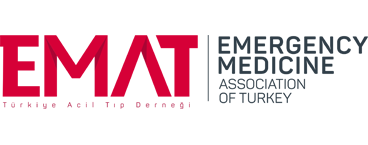Clinical Indicators of Traumatic Brain Injury and Skull Fracture in Pediatric Head Trauma Patients
Murat ÖZSARAÇ1, Özgür KARCIOĞLU2, Hakan TOPAÇOĞLU3, Cüneyt AYRIK4, Selahattin KIYAN1, Serkan SENER5, Serhat GÜMRÜKÇÜ6, Yücel DEMİRAL7, Hatice ULUER8
1Ege University, Department Of Emergency Medicine, İzmir
2Acıbadem University, Department Of Emergency Medicine, İstanbul
3Dokuz Eylul University, Department Of Emergency Medicine, İzmir
4Mersin University Department Of Emergency Medicine, Mersin
5Acibadem Hospital, Department Of Emergency Medicine, Bursa
6Dokuz Eylul University, School Of Medicine Phase Vı Student, İzmir
7Dokuz Eylul University, Department Of Public Health, İzmir
8Ege University, Biostatistics And Medical Informatics, İzmir
Keywords: Computed tomography, head injuries, physical examination, skull fracture, traumatic brain injury
Abstract
Background: To determine whether clinical signs and symptoms of brain injury are sensitive indicators of traumatic brain injury (TBI) and skull fracture (SF) in pediatric patients admitted with head trauma.
Methods: A retrospective cross-sectional analysis of all patients younger than 17 years of age admitted to the university-based pediatric Emergency Department (ED) with the complaint of head trauma during a 7-year period was conducted. All children who were admitted into pediatric emergency department had a TBI and/or SF were included in the study.
Results: 1167 patients with the chief complaint of head trauma were admitted to pediatric emergency department during the study period. Of these, 984 subjects were excluded because they had no acute radiographic abnormalities noted or had inadequate records of symptoms. The remaining 183 subjects constituted the study sample. Isolated TBI without SF was found in 40 (21.9%) patients, whereas isolated SF was found in 82 (44.8%) patients, and both TBI and SF were found in 61 (33.3%) patients. Forty five (44.6%) of the patients who had TBI were conscious, with GCS of 15 and had no focal neurological abnormalities. The most common mechanism of head injury was >5- feet fall. Findings that were not significantly associated with TBI were vomiting, post-traumatic seizure, lethargy, irritability, and scalp hematoma without loss of consciousness (LOC) (p=0.044). There was a significantly higher incidence of scalp hematoma (p=0.015) and LOC (p=0.052) in children with SF.
Conclusion: Our results support that seizure, vomiting, lethargy, scalp hematoma, irritability and LOC are insensitive clinical predictors of TBI. LOC appear to be a risk predictor of TBI for patients of only those younger than 2 years old. Scalp hematoma is a potential risk factor for SF.

